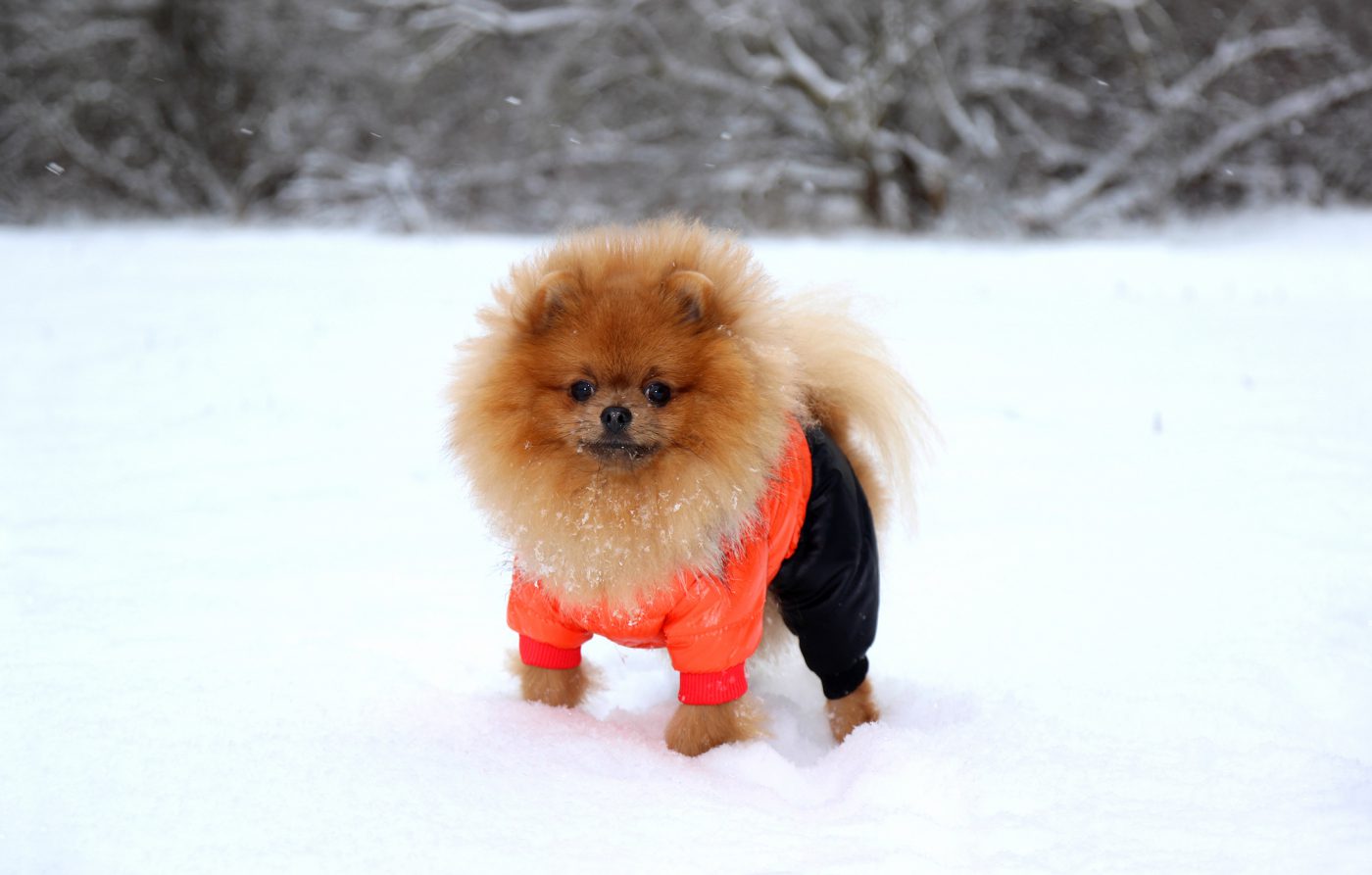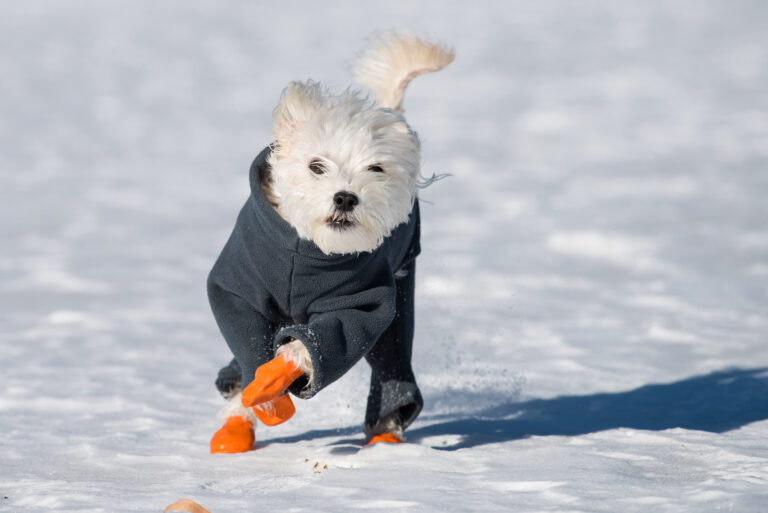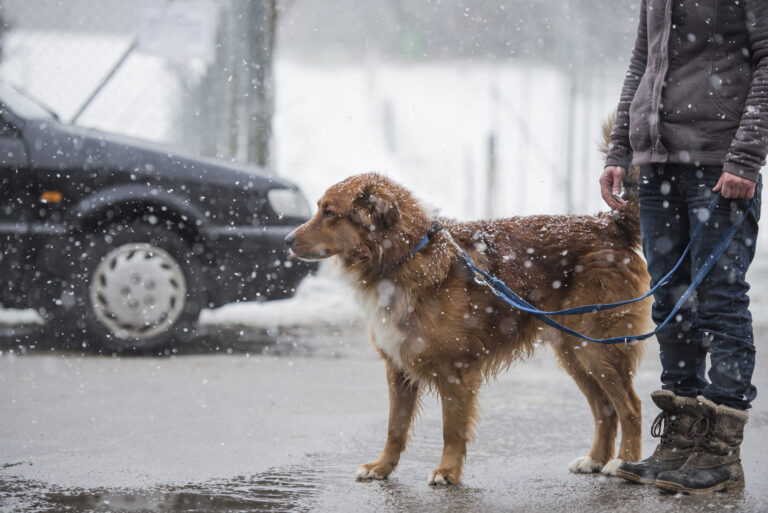When temperatures drop and the likelihood of snow and other wintry weather patterns increases, we (mostly) fur-free bipeds break out the winter jackets and snow boots. But are humans the only ones who need to rock special gear during the coldest months of the year, or do dogs need winter boots, too?
As with many things concerning dog care, the answer is not a clear-cut yes or no. Here’s what you need to know to decide if and when winter boots are right for your dog.
Does your dog need to wear boots in the cold?
When it comes to whether your canine companion should wear boots during the winter, it depends on your dog’s tolerance for cold, how cold it is, what’s happening under their paws, and several other factors.
Dogs are built for the cold—for the most part
While humans aren’t able to stand barefoot in the cold without risking discomfort and even frostbite, dogs can and will walk around in the cold and snow like it’s no big deal, thanks to the amazing way their paws work. So when it comes to booting up strictly to combat the cold, most dogs don’t need the extra protection for average cold-weather conditions.
We’ve written previously about the wonder of your dog’s paws and how they’re built to support and protect your four-legged friend in all manner of weather, including wintry temperatures. Paw pads are made up of adipose tissue and elastic fibers, which are in turn covered by heavily pigmented, thick skin. All of these elements inhibit freezing, of course, but that’s not the only thing that allows them to frolic in the snow.
Recent research has shown that it’s not just the combination of fat, fiber, and thick skin that keeps dogs’ paws warm—canines also have a special circulatory system in their paws that places arteries and veins in close proximity and allows warm blood to be circulated more quickly.
Also found in penguins and dolphins, it’s essentially a heat exchange system that brings warm blood from the body down into the paws, heating the blood that has been close to cold surfaces before it circulates throughout the rest of the dog’s body. This keeps their entire body temperature stable and allows them to comfortably amble around sans extra protection.
But sometimes the cold is too much
That said, not all dogs are equipped to keep themselves warm enough to withstand winter temperatures and conditions like snow and ice.
Smaller breeds and those with short, thin, or no coats (for example, Chinese crested dogs or other hairless breeds) may have difficulty staying warm, so you might need extra help to keep their body temperature stable. Though paws are wonderful heat conductors, if you’re planning to be outside for any length of time, boots keep a dog’s paws dry and create an extra layer of insulation. Look for boots that are specifically designed to handle winter temperatures; they are generally made of waterproof material and are thick enough to insulate.
When even the hardiest dogs need boots
There are plenty of cold-weather dogs, such as huskies, who thrive when it drops below freezing and don’t require boots to help them maintain a safe body temperature. But even huskies, Akitas, and other cold weather breeds need foot protection sometimes.
Rock salt and chemical de-icers
If you live in an area where your neighbors throw salt on the sidewalks or the city salts the streets to melt snow and ice, putting boots on your pup’s paws is a good idea.
Whether it’s rock salt or a chemical melting agent such as calcium chloride or magnesium chloride, snow and ice melting agents, and the slushy slurry they produce, can harm a dog’s paw pads. Rock salt can physically tear paw pads, and the chemicals used to melt ice can irritate and even heat up and burn your dog’s pads.
Magnesium chloride, for example, can cause excessive dryness, which can lead to tears in the skin. And when dogs’ paws get irritated, they get licked, which means your dog is ingesting these salts and other chemicals. In extreme cases, compounds like sodium chloride, calcium chloride, and magnesium chloride can cause burns, respiratory issues, vomiting and diarrhea, and even seizures. If you’re responsible for de-icing your sidewalk or driveway, consider alternatives like dirt or wood ash (or, if possible, just shovel!).
The best way to protect your pup from paw pad injuries is to boot up, putting a protective layer between them and the chemicals that melt snow.
Keeping your dog’s paws well-groomed, trimming the excess hair between their paw pads, helps snow and ice from accumulating on their tootsies. You may also consider using veterinarian-approved paw wax to create for a temporary barrier to the elements (note that wax shouldn’t be considered a replacement for boots in extreme cold, or for guarding against de-icers).
Hiking in the cold
If you plan on hiking in the winter, you might also want to consider boots for your dog. Anywhere you’ll find sharp rock such as shale, rock scrambles, or any other hard surfaces that could cause paw pad injuries, boot up. These kinds of injuries, such as hot spots and tears, can be exacerbated by cold weather conditions and exposure to de-icers.
Certain boots have the added benefit of giving your dog better grip while scrambling up particularly challenging terrain.
For both hiking and protecting dogs from de-icers, you don’t necessarily need insulated boots; rubber boots that protect from the terrain and add grip should suffice.
Watch the warm weather, too
Your dog can burn their paws on steaming hot asphalt. If you’re walking on a hot day, check the pavement with your own hand. If it’s too hot for you, it’s too hot for your dog to walk on it for any length of time. Try to keep walks to cooler times of the day, and opt for cooler surfaces, like grass. But boots or other foot coverings can provide protection if contact with hot pavement is anticipated (just don’t leave paw-coverings on too long in warm weather).
How to get your dog used to boots
Some dogs are able and willing to wear boots right out of the gate. Most dogs, however, are not amenable to having foreign objects strapped to their feet. (We’ve all seen the videos of dogs doing the high-step as they struggle to walk in their new boots—more on that below.) Follow this step-by-step guide to get your dog ready to wear their boots outside.
- Put your dog’s boots on the floor and let them sniff around. Use praise and/or treats to reinforce their curiosity. If they’re not interested in the boots at all, try putting some treats inside.
- Slowly introduce them to the feel of the boots, first touching them to the paws while offering rewards, then putting on one boot at a time.
- After every boot, praise and/or give treats to your dog to reinforce the positive experience of wearing them.
- Once you get all four boots on, let them walk (or hop) around the house while praising them. Take the boots off after only a few minutes.
- Add on more time for each subsequent session, and eventually transition to taking them outside.
- After they become (relatively) comfortable wearing their boots outside, start taking them on short neighborhood walks, increasing the length every time, until they’re walking normally and ready for winter.
Why do dogs walk funny when you first put boots on them?
Unlike humans, dogs haven’t had a lifetime of experience moving around with their feet wedged into coverings. They’ve spent their whole lives with paws on the ground, so it’s natural that when first introduced to boots, they’re thrown for a loop. It’s thought that boots can interfere with proprioception—the sense of where a body is in space. As noted, dogs’ paws are wonders of design—they are attuned to temperature and composition of the surface they’re walking on, so when their paw pads aren’t touching the actual ground, that information isn’t getting from the paw to the brain. A foot covering is also interfering with a dog’s finely tuned sense of balance and traction, so each step can feel precarious. Another theory is that since a dog is so used to stepping on the ground with bare paws, the sensation of something “sticking” to their feet when they lift their paw makes it seem like the ground is sort of stuck to their foot. The long and short is that it feels weird. So, whenever possible, let your dog walk au naturel. But when boots are necessary, introduce them slowly and give your dog some time to get used to the sensation.
Once your dog is ready to face the world in their boots, go out and enjoy the winter wonderland.












